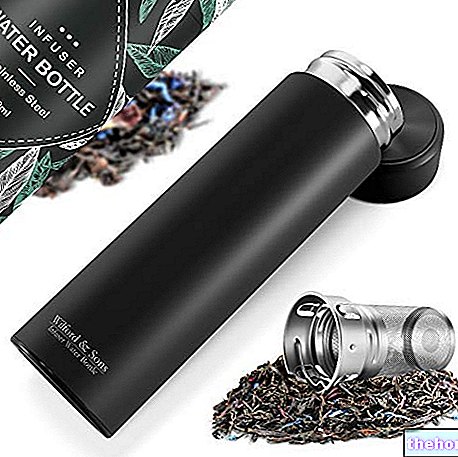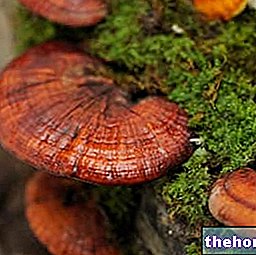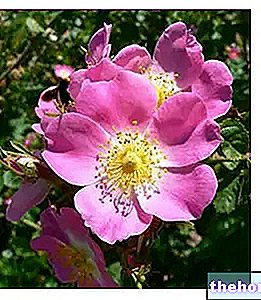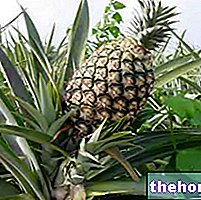Glycyrrhiza glabra L.
Fam. Fabaceae ( Leguminosae Papilionaceae)
Fran: Réglisse
English: Licorice
Spag: Regaliz
Ted: Sussholz
Namedialectals: regulation, glicirriza, argolizia, niculizia, rebulizia, gurigulizia, glisirizza, arregalizia, ragadinzia, rigorizza, migulezzia, niclizia.
Description
Licorice is a suffrutice plant with erect, cylindrical, glabrous, striated, branched stems, 100-150 cm tall.
Hairless imparipinnato-compound leaves formed by 4-7 pairs of elliptical leaflets.
Very developed hypogeal portion of the plant consisting of rhizomes which, in the second year of life, give rise to new shoots, and sarmentose roots.

The small flowers, blue-purplish in color, gathered in pedunculated axillary racemes. They have calyx covered with glandular hairs, formed by 5 sepals welded to the base. The licorice blooms in summer (June-July).
The fruit is a legume, 2-3 cm long, containing 2-5 seeds, kidney-shaped or lenticular, brown in color.
The rhizomes have a slightly accentuated aroma, while the taste is first sweet and then gradually bitter.
In the "context of the species, 3 varieties are distinguished:
1.G.glabra var.typica Reg. Et Herd., With hairless legumes, also called liquorice of Spain, which is found spontaneously in the Mediterranean area and provides the best quality product since it has the highest content of glycyrrhizin; both the rhizomes and the roots have the bark of brown color and the innermost portions pale yellow;
2. G.glabra var. glandulifera Waldst. et Kit., characterized by having the lower portions of the leaves and the legumes covered with thin slimy bristles and by not having stolons; it is called licorice of Russia and is widespread in Eastern Europe;
3. G.glabra var. purplish Boiss., Characterized by large diameter roots (7-8cm) and deep purple flowers, is also known as Turkish or Persian licorice and is widespread in the Middle Eastern area.
There are also other species such as G. uralensis Fish. or Chinese licorice which has a low sugar content, or as the G. echinata L. or Hungarian licorice with small pods with quills.
Areal
Licorice is native to the Mediterranean and Middle Eastern area; the first evidence of its medicinal use comes from ancient Egypt. The typical species grows spontaneously in Italy in Calabria and in Sicily and in Spain. It prefers salty soils and those subject to periodic submersion or with a high water table, but in any case warm and deep. Salinity, however, causes the production of thinner roots and rhizomes even if richer in sugar than those of unsalted soils.
Culture
Licorice is grown in Spain, Italy, France, Turkey, Greece, Iran, Iraq and Syria.
The planting of the licorice culture is rarely performed starting from the seed since it hardly allows to obtain uniform plants and high yields and also delays the harvesting period by 1-2 years. If you want to resort to sowing, the seed, placed at a depth not exceeding 2 cm, must be placed in rows spaced around 50 cm. The most usual planting technique consists in taking rhizomes 10-15 cm long and 1-1.5 cm in diameter with at least 3 nodes from a licorice crop already in place. These, immediately after harvesting, are planted horizontally on the bottom of furrows 20-30 cm deep, arranged in rows 70-90 cm apart. After planting, irrigation is often necessary. The licorice plant takes advantage of phosphate fertilization while it seems to be negatively affected by the nitrogen richness of the soil. In particular, it has been seen that nitrogen determines the production of rhizomes and poor roots of active principles.
ADVERSITY: Licorice can be damaged by fungi: Uromyces glycyrrhizae, a rust that attacks leaves and stems; Cercospora cavarea, which attacks the leaves; Sclerotium sp., which develops on the rhizomes. Damages of a certain entity can instead be made to the roots stored in the warehouse by some beetle insects such as Bostrychus capucinus, Ptinus fur, Silvanus surinamensis, Stegobium paniceum.
As for the fight against weeds, it is especially useful in the first year of life; subsequently the crop covers the soil well and is able to compete effectively with weeds.
HARVEST AND RETURNS: in the autumn of the third year, when the leaves begin to dry and after the aerial part of the plant has been mowed and removed from the field, the roots and rhizomes are harvested with the help of stiff-toothed grubbers. close together that bring the underground parts of the plant to the surface. As a rule, it is not possible to remove all the rhizomes present in the soil, therefore the share of these that remains in the soil is almost always able to make the crop persist on the same plot. After harvesting, the rhizomes and roots (which have a humidity of about 50%) are reduced into fragments of 20-30 cm, dried up to 10% humidity, assembled in bales of 20-40 kg and sent for subsequent processing. . A good licorice crop can produce up to 20 t / ha of moist rhizomes and roots.
The seed yield is about 0.4-0.5t / ha.
Uses
In herbal medicine and phytotherapy, licorice is used for its beneficial action on stomach ulcers, even if it has been shown to be hypertensive in large doses; in fact the active principle of greatest interest, glycyrizin, which is a strong sweetener (50-100 times higher than sucrose), favors the retention of sodium and water in animal cells, consequently reducing the body's need for water. Licorice also has calming and expectorant, purifying, digestive, refreshing and tonic properties. Licorice has expectorant properties (secretolytic and secretomotor action); it is often used in herbal teas as a corrective to flavor. Licorice can potentiate the loss of potassium salts caused by other drugs, such as thiazides; for this reason it is advisable not to exceed the indicated doses and not to exceed a month of treatment.
In dietetics, due to its pleasant taste, it is used in liqueurs, in confectionery, for the darkening of beer. Another constituent is glycestrone which has estrogenic activity.
Other uses: the residue of roots and rhizomes after the extraction of the active ingredients, treated with caustic soda, is used to extract a stabilizer of fire-fighting foams. The further residue is used in the preparation of pastes suitable for the construction of insulating panels.
Select plant Fir Acacia Acerola Sorrel Yarrow Yarrow Yarrow Aconito Adatoda Garlic Agnocasto Agrimonia Alchemilla Alkekengi Aloe Altea Witch Hazel Ammi or Visnaga Pineapple Andrographis Anemone Pulsatilla Angelica Anise Star Anise Japanese Star Anise Bitter Orange Bitter Areca Arnica Harpagophytum Arpagophyte Artemisia Asteragus Basil Asparagus Asparagus Peruvian Asparagus Asparagus Asparagus Hawthorn Boldo Borage Shepherd's Purse Boswellia Bucco Butea superba Cocoa Coffee Cajeput Calamus Calamus Marigold Camedrio Chamomile Roman Chamomile Camphor Cinnamon Ceylon Maidenhair Capuchin Artichoke Cardamom Cardiac Thistle Asian Thistle Carvi Cascara Cassia Catecu Catha Cabbage Celandine Chicory Centaurea Cinnamon Cypress Celandine Chives Cypress Coca Cola Colchico Combreto Condurango Comfrey Coriander Cranberry Barberry American Chrysanthemum Cumin Turmeric Damiana Digital Dioscorea Drosera Dulcamara Dunalilella Echinacea Eder a Ephedra Elenio Eleutherococcus Helichrysum Evening primrose Horsetail Alfalfa Erica Euphrasia Erisimo Escolzia Eucalyptus Farfara Farfaraccio Calabar bean Fenugreek Fennel Phytolacca Frangola Ash Fumaria Japanese Mushrooms Galega Ganoderma lucidum Garcinia Cambogia Mulberry Gentian Broom Ginkgo Ginkgo Guipana Guipana Gynestra Ginkgo Hibelia Gymnasium Hibiscus Guarulp St. John's Wort Horse Chestnut Ispaghul Hyssop Jaborandi Kava kava Konjac Laminaria Cherry Laurel Lavender Lemongrass Lespedeza Lovage Icelandic Lichen Lemon Flax Lippia Licorice Lobelia Hops Maca Marjoram Maize Mallow Manna Marrubio Marrubio d "water Matè Melaleuca Meliloto American Lemon balm Myrtle Myrama Walnut Nutmeg Walnut vomica Olive tree Meadowsweet Ononide Opuntia Oregano Orthosiphon Nettle Poppy Papaya Parietaria Feverfew Passiflora Chilli Perilla Periwinkle Phyllanthus Plantain Picrorhiza Pilosella Pino Pisci dia Podofillo Polygala Grapefruit Parsley Psyllium Pueraria mirifica Butcher's broom Pygeum Quassia Oak Rhubarb Ratania Rauwolfia currant Castor bean Rhodiola Rosehip Rosemary Rue Willow Sarsaparilla Sage Elderberry Sassafras Sedum Ergot Senna Serenoa Repens Soybean Solidago Tansy Taraxus Tamarind Tamarind Tamarind Tamarind Tamarindo Ursina Valerian Vanilla Mullein Verbena Veronica Viburnum Vinca Pansy Mistletoe Vine Withania Yohimbe Saffron Ginger Pumpkin Select disease Juvenile Acne Rosacea Tinnitus Tinnitus Aerophagia Tendon Affections Afonia Aphthae Algias Functional Halitosis Breastfeeding Allergy Anemia Anguish Anxiety Arteriosclerosis Asthrosis Asthrosis Arthritis Arthritis Men Sex Woman Blepharitis and Conjunctivitis Eye bags Bronchitis Gallstones Kidney stones Salivary stones Baldness Androgenetic Candida Fragile hair Caries Headache Cellulitis Motion sickness Cystitis C limaterio Cholecystopathy High cholesterol Ulcerative colitis Colonoscopy Contusions Hematoma Convalescence Couperose Depression Dermatitis Diaper dermatitis Diabetes Diarrhea Erectile dysfunction Dyslipidemia Dysmenorrhea Dyspepsia Disturbances of vision Hemorrhoids Epistaxis Herethism Heart disease Fever Fibromyalgia Gastro-intestinal disease Flatulence Hypertension Fibromyalgia Gastrointomnia Jaundice Laryngitis Renal lithiasis Toothache Sore throat Thinness Menopause Meteorism Mononucleosis Alzheimer's disease Crohn's disease Nausea Vomiting Obesity Dark circles Onychomycosis Osteoporosis Dry skin Periarthritis Piorea Low pressure Prostatitis Psoriasis Colds Breast fissures Anal fissures Gastro-nasal rhinitis Senescence Premenstrual Syndrome Sinusitis Quit smoking Overweight Fatty liver Constipation Stomatitis Stress Cough Triglycerides high Ulcer Burns Nails Brittle flashes Heat Warts Dizziness Properties herbal Tanning Abortive adaptogenic Aphrodisiac bittering analgesic anesthetic anorectics analgesic antacid anti-allergic anti-asthmatic Antibiotic catarrh Anticellulitiche anticonvulsant Antidiaforetiche antidiarrheal edematous anthelmintic antiemetic Antiemorroidarie antiphlogistic Antiidrotiche Antinevrotiche Antioxidants antipyretic antirheumatic antiscorbutic Antiseptic antispasmodic anti-uric Aperitive Flavoring Astringent Balsamic Bechiche Capillarotrope Cardiotonic Carminative Cathartic Caustics Healing Cholagogues Choleretic Dyes Decongestants Deodorants Purifying Diaphoretic Cleansers Disinfectants Detoxifiers Thirst quenching Diuretics Exciting Emetics Emmenagogues Emollients Hemostatic Energies Hepatoprotectors Expectorants Eupepticus Moisturisers Galactosensitizers lanti Hypertensive Hypnotic Hypoglycemic Hypotensive Irritants Laxatives Soothing Narcotic Nerves Nutrients Odontalgic Pectoral Purgative Revulsive Remineralizing Refreshing Rubefacient Scialagoghe Sedative Soporifugas Sneezing Stomachic Stomatics Narcotic Vascular Tightenitis























-nelle-carni-di-maiale.jpg)




